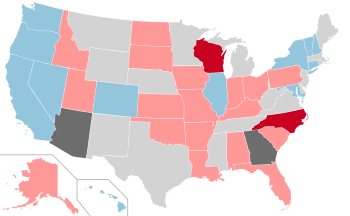2022 United States elections
The 2022 United States elections will be held on Tuesday, November 8, 2022, in the middle of the term of the president elected in 2020. During this mid-term election year, all 435 seats in the United States House of Representatives and 34 of the 100 seats in the United States Senate will be contested. 39 state and territorial governorships and numerous other state and local elections will also be contested. This will be the first election affected by the redistricting that will follow the 2020 United States Census.
| ← 2021 2022 2023 → Mid-term elections | |
| Election day | November 8 |
|---|---|
| Incumbent president | TBD |
| Next Congress | 118th |
| Senate elections | |
| Seats contested | 34 of 100 seats |
 | |
| Map of the 2022 Senate races
Democratic incumbent Republican incumbent Retiring Republican incumbent Incumbent unknown | |
| House elections | |
| Seats contested | All 435 voting seats +5 of 6 non-voting seats |
| Gubernatorial elections | |
| Seats contested | 39 (36 states, 3 territories) |
 | |
| Map of the 2022 gubernatorial elections Democratic incumbent | |
Federal elections
Senate elections
At least 34 of the 100 seats in the United States Senate will be up for election, including all 34 Class III seats. Special elections may also be held to fill vacancies in the other two Senate Classes. As senators serve six-year terms, the last regularly-scheduled elections for Class III senators were held in 2016.
House of Representatives elections
All 435 voting seats in the United States House of Representatives will be up for election. As of April 2019, only one representative, Steve Cohen (D-TN) has announced his plan to run again in 2022.[1] The incumbents in these races will be determined in the 2020 House of Representatives elections and subsequent special elections. As these elections will be the first conducted after the post-2020 Census redistricting, several districts may lack an incumbent or have multiple incumbents.
Additionally, elections will be held to select the non-voting delegate for the District of Columbia, as well as four of the five non-voting delegates from U.S. territories.[lower-alpha 1]
State elections
Gubernatorial elections
Elections will be held for the governorships of 36 U.S. states and three U.S. territories. Special elections may be held for vacancies in the other states and territories, if required by respective state and territorial constitutions. As most governors serve four-year terms, the last regularly-scheduled elections for most seats up for election in 2022 were held in 2018. The governors of New Hampshire and Vermont each serve two-year terms, so incumbents in those two states will be determined by the 2020 gubernatorial elections.
Legislative elections
The vast majority of states and territories will hold legislative elections in 2022. Louisiana, Mississippi, New Jersey, and Virginia will not hold state legislative elections, as those states all hold such elections in odd-numbered years. In states that use staggered terms, some state senators will not be up for election. As these elections will be the first conducted after the post-2020 Census redistricting, several legislative districts may lack an incumbent or have multiple incumbents.
Notes
- The Resident Commissioner of Puerto Rico serves a four-year term and will not be up for election in 2022.
References
- Burgess, Katherine (January 1, 2019). "Cohen to seek re-election to Congress in 2020 and 2022". The Commercial Appeal. Retrieved April 11, 2019.